Philipp Altmann
Towards Scalable Lottery Ticket Networks using Genetic Algorithms
Aug 12, 2025Abstract:Building modern deep learning systems that are not just effective but also efficient requires rethinking established paradigms for model training and neural architecture design. Instead of adapting highly overparameterized networks and subsequently applying model compression techniques to reduce resource consumption, a new class of high-performing networks skips the need for expensive parameter updates, while requiring only a fraction of parameters, making them highly scalable. The Strong Lottery Ticket Hypothesis posits that within randomly initialized, sufficiently overparameterized neural networks, there exist subnetworks that can match the accuracy of the trained original model-without any training. This work explores the usage of genetic algorithms for identifying these strong lottery ticket subnetworks. We find that for instances of binary and multi-class classification tasks, our approach achieves better accuracies and sparsity levels than the current state-of-the-art without requiring any gradient information. In addition, we provide justification for the need for appropriate evaluation metrics when scaling to more complex network architectures and learning tasks.
Surrogate Fitness Metrics for Interpretable Reinforcement Learning
Apr 20, 2025Abstract:We employ an evolutionary optimization framework that perturbs initial states to generate informative and diverse policy demonstrations. A joint surrogate fitness function guides the optimization by combining local diversity, behavioral certainty, and global population diversity. To assess demonstration quality, we apply a set of evaluation metrics, including the reward-based optimality gap, fidelity interquartile means (IQMs), fitness composition analysis, and trajectory visualizations. Hyperparameter sensitivity is also examined to better understand the dynamics of trajectory optimization. Our findings demonstrate that optimizing trajectory selection via surrogate fitness metrics significantly improves interpretability of RL policies in both discrete and continuous environments. In gridworld domains, evaluations reveal significantly enhanced demonstration fidelities compared to random and ablated baselines. In continuous control, the proposed framework offers valuable insights, particularly for early-stage policies, while fidelity-based optimization proves more effective for mature policies. By refining and systematically analyzing surrogate fitness functions, this study advances the interpretability of RL models. The proposed improvements provide deeper insights into RL decision-making, benefiting applications in safety-critical and explainability-focused domains.
PIMAEX: Multi-Agent Exploration through Peer Incentivization
Jan 02, 2025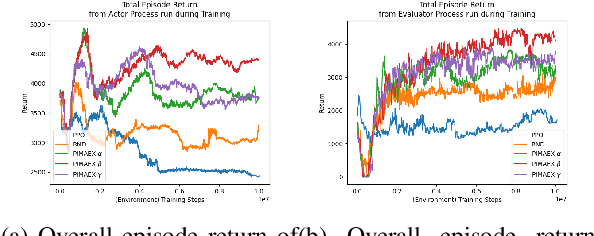
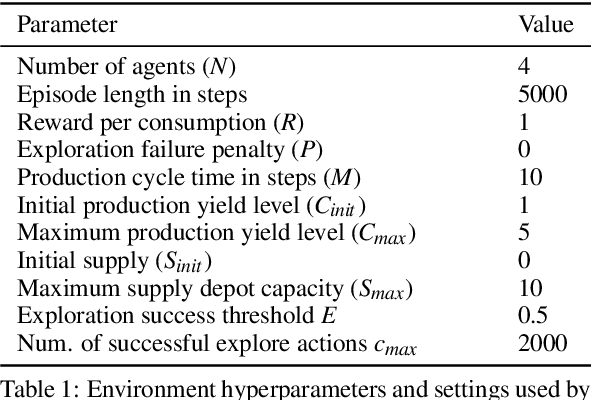
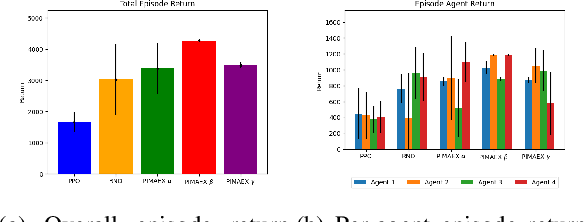
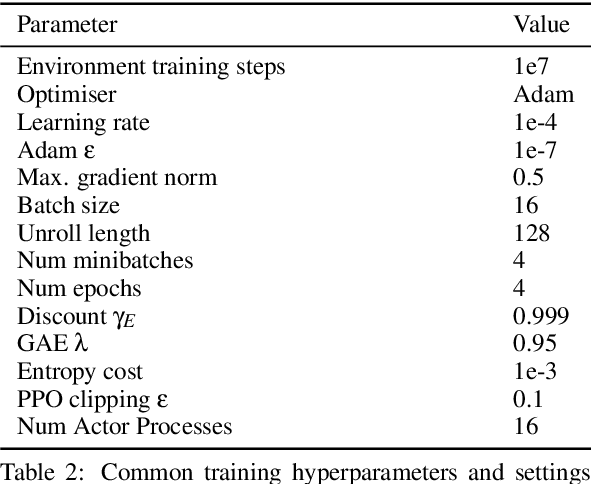
Abstract:While exploration in single-agent reinforcement learning has been studied extensively in recent years, considerably less work has focused on its counterpart in multi-agent reinforcement learning. To address this issue, this work proposes a peer-incentivized reward function inspired by previous research on intrinsic curiosity and influence-based rewards. The \textit{PIMAEX} reward, short for Peer-Incentivized Multi-Agent Exploration, aims to improve exploration in the multi-agent setting by encouraging agents to exert influence over each other to increase the likelihood of encountering novel states. We evaluate the \textit{PIMAEX} reward in conjunction with \textit{PIMAEX-Communication}, a multi-agent training algorithm that employs a communication channel for agents to influence one another. The evaluation is conducted in the \textit{Consume/Explore} environment, a partially observable environment with deceptive rewards, specifically designed to challenge the exploration vs.\ exploitation dilemma and the credit-assignment problem. The results empirically demonstrate that agents using the \textit{PIMAEX} reward with \textit{PIMAEX-Communication} outperform those that do not.
Swarm Behavior Cloning
Dec 10, 2024Abstract:In sequential decision-making environments, the primary approaches for training agents are Reinforcement Learning (RL) and Imitation Learning (IL). Unlike RL, which relies on modeling a reward function, IL leverages expert demonstrations, where an expert policy $\pi_e$ (e.g., a human) provides the desired behavior. Formally, a dataset $D$ of state-action pairs is provided: $D = {(s, a = \pi_e(s))}$. A common technique within IL is Behavior Cloning (BC), where a policy $\pi(s) = a$ is learned through supervised learning on $D$. Further improvements can be achieved by using an ensemble of $N$ individually trained BC policies, denoted as $E = {\pi_i(s)}{1 \leq i \leq N}$. The ensemble's action $a$ for a given state $s$ is the aggregated output of the $N$ actions: $a = \frac{1}{N} \sum{i} \pi_i(s)$. This paper addresses the issue of increasing action differences -- the observation that discrepancies between the $N$ predicted actions grow in states that are underrepresented in the training data. Large action differences can result in suboptimal aggregated actions. To address this, we propose a method that fosters greater alignment among the policies while preserving the diversity of their computations. This approach reduces action differences and ensures that the ensemble retains its inherent strengths, such as robustness and varied decision-making. We evaluate our approach across eight diverse environments, demonstrating a notable decrease in action differences and significant improvements in overall performance, as measured by mean episode returns.
Finding Strong Lottery Ticket Networks with Genetic Algorithms
Nov 07, 2024Abstract:According to the Strong Lottery Ticket Hypothesis, every sufficiently large neural network with randomly initialized weights contains a sub-network which - still with its random weights - already performs as well for a given task as the trained super-network. We present the first approach based on a genetic algorithm to find such strong lottery ticket sub-networks without training or otherwise computing any gradient. We show that, for smaller instances of binary classification tasks, our evolutionary approach even produces smaller and better-performing lottery ticket networks than the state-of-the-art approach using gradient information.
Architectural Influence on Variational Quantum Circuits in Multi-Agent Reinforcement Learning: Evolutionary Strategies for Optimization
Jul 30, 2024



Abstract:In recent years, Multi-Agent Reinforcement Learning (MARL) has found application in numerous areas of science and industry, such as autonomous driving, telecommunications, and global health. Nevertheless, MARL suffers from, for instance, an exponential growth of dimensions. Inherent properties of quantum mechanics help to overcome these limitations, e.g., by significantly reducing the number of trainable parameters. Previous studies have developed an approach that uses gradient-free quantum Reinforcement Learning and evolutionary optimization for variational quantum circuits (VQCs) to reduce the trainable parameters and avoid barren plateaus as well as vanishing gradients. This leads to a significantly better performance of VQCs compared to classical neural networks with a similar number of trainable parameters and a reduction in the number of parameters by more than 97 \% compared to similarly good neural networks. We extend an approach of K\"olle et al. by proposing a Gate-Based, a Layer-Based, and a Prototype-Based concept to mutate and recombine VQCs. Our results show the best performance for mutation-only strategies and the Gate-Based approach. In particular, we observe a significantly better score, higher total and own collected coins, as well as a superior own coin rate for the best agent when evaluated in the Coin Game environment.
A Study on Optimization Techniques for Variational Quantum Circuits in Reinforcement Learning
May 20, 2024Abstract:Quantum Computing aims to streamline machine learning, making it more effective with fewer trainable parameters. This reduction of parameters can speed up the learning process and reduce the use of computational resources. However, in the current phase of quantum computing development, known as the noisy intermediate-scale quantum era (NISQ), learning is difficult due to a limited number of qubits and widespread quantum noise. To overcome these challenges, researchers are focusing on variational quantum circuits (VQCs). VQCs are hybrid algorithms that merge a quantum circuit, which can be adjusted through parameters, with traditional classical optimization techniques. These circuits require only few qubits for effective learning. Recent studies have presented new ways of applying VQCs to reinforcement learning, showing promising results that warrant further exploration. This study investigates the effects of various techniques -- data re-uploading, input scaling, output scaling -- and introduces exponential learning rate decay in the quantum proximal policy optimization algorithm's actor-VQC. We assess these methods in the popular Frozen Lake and Cart Pole environments. Our focus is on their ability to reduce the number of parameters in the VQC without losing effectiveness. Our findings indicate that data re-uploading and an exponential learning rate decay significantly enhance hyperparameter stability and overall performance. While input scaling does not improve parameter efficiency, output scaling effectively manages greediness, leading to increased learning speed and robustness.
Qandle: Accelerating State Vector Simulation Using Gate-Matrix Caching and Circuit Splitting
Apr 14, 2024



Abstract:To address the computational complexity associated with state-vector simulation for quantum circuits, we propose a combination of advanced techniques to accelerate circuit execution. Quantum gate matrix caching reduces the overhead of repeated applications of the Kronecker product when applying a gate matrix to the state vector by storing decomposed partial matrices for each gate. Circuit splitting divides the circuit into sub-circuits with fewer gates by constructing a dependency graph, enabling parallel or sequential execution on disjoint subsets of the state vector. These techniques are implemented using the PyTorch machine learning framework. We demonstrate the performance of our approach by comparing it to other PyTorch-compatible quantum state-vector simulators. Our implementation, named Qandle, is designed to seamlessly integrate with existing machine learning workflows, providing a user-friendly API and compatibility with the OpenQASM format. Qandle is an open-source project hosted on GitHub https://github.com/gstenzel/qandle and PyPI https://pypi.org/project/qandle/ .
REACT: Revealing Evolutionary Action Consequence Trajectories for Interpretable Reinforcement Learning
Apr 04, 2024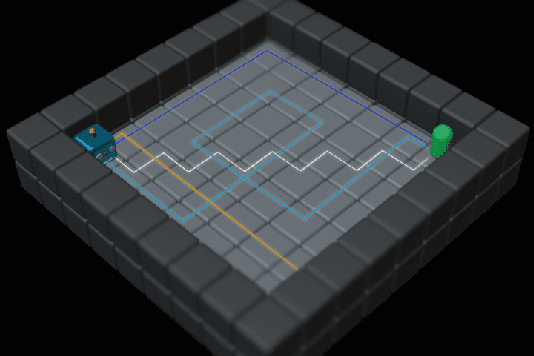
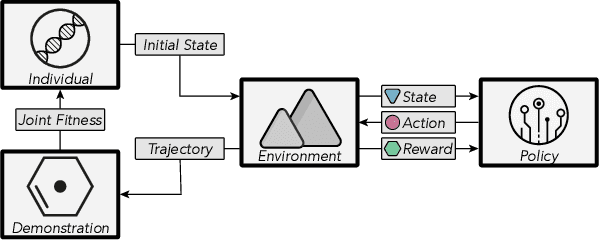

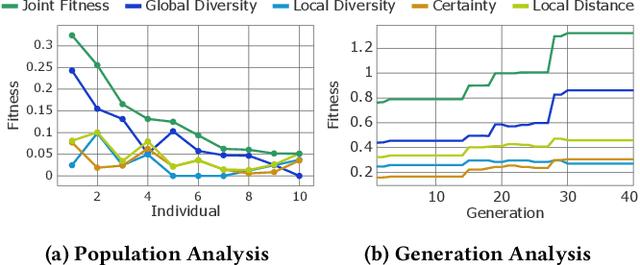
Abstract:To enhance the interpretability of Reinforcement Learning (RL), we propose Revealing Evolutionary Action Consequence Trajectories (REACT). In contrast to the prevalent practice of validating RL models based on their optimal behavior learned during training, we posit that considering a range of edge-case trajectories provides a more comprehensive understanding of their inherent behavior. To induce such scenarios, we introduce a disturbance to the initial state, optimizing it through an evolutionary algorithm to generate a diverse population of demonstrations. To evaluate the fitness of trajectories, REACT incorporates a joint fitness function that encourages both local and global diversity in the encountered states and chosen actions. Through assessments with policies trained for varying durations in discrete and continuous environments, we demonstrate the descriptive power of REACT. Our results highlight its effectiveness in revealing nuanced aspects of RL models' behavior beyond optimal performance, thereby contributing to improved interpretability.
A Reinforcement Learning Environment for Directed Quantum Circuit Synthesis
Jan 13, 2024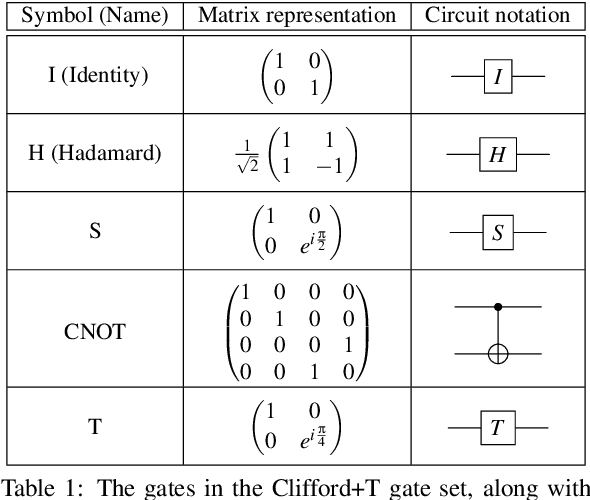
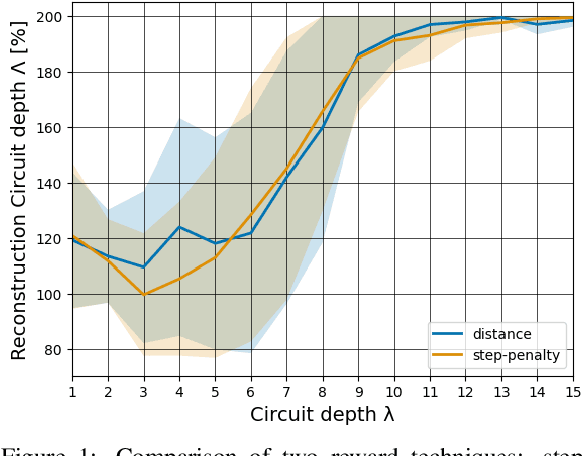
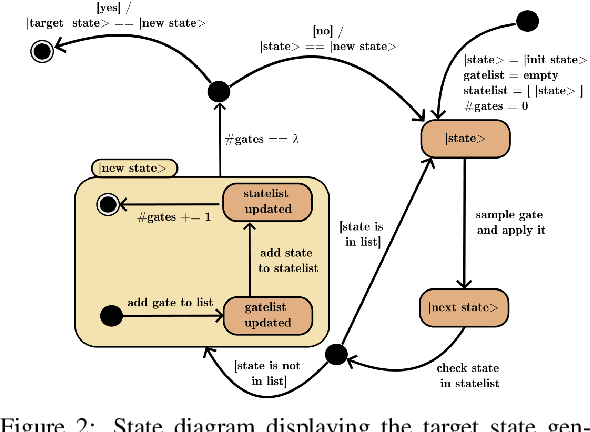
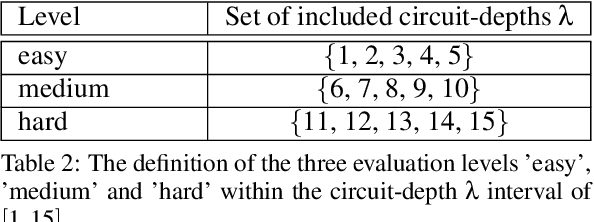
Abstract:With recent advancements in quantum computing technology, optimizing quantum circuits and ensuring reliable quantum state preparation have become increasingly vital. Traditional methods often demand extensive expertise and manual calculations, posing challenges as quantum circuits grow in qubit- and gate-count. Therefore, harnessing machine learning techniques to handle the growing variety of gate-to-qubit combinations is a promising approach. In this work, we introduce a comprehensive reinforcement learning environment for quantum circuit synthesis, where circuits are constructed utilizing gates from the the Clifford+T gate set to prepare specific target states. Our experiments focus on exploring the relationship between the depth of synthesized quantum circuits and the circuit depths used for target initialization, as well as qubit count. We organize the environment configurations into multiple evaluation levels and include a range of well-known quantum states for benchmarking purposes. We also lay baselines for evaluating the environment using Proximal Policy Optimization. By applying the trained agents to benchmark tests, we demonstrated their ability to reliably design minimal quantum circuits for a selection of 2-qubit Bell states.
 Add to Chrome
Add to Chrome Add to Firefox
Add to Firefox Add to Edge
Add to Edge